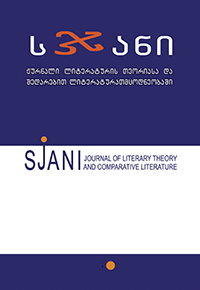ქართული მყარი სალექსო ფორმების აღმოსავლური წყაროები
Oriental Sources of Georgian Stable Verse Forms
Author(s): Apollon SilagadzeSubject(s): Theory of Literature
Published by: ლიტერატურის ინსტიტუტის გამომცემლობა
Keywords: Georgian; oriental; versifcation; form; verse; stable;
Summary/Abstract: To determine the fixed verse form as a versification phenomenon, the paper gives a brief outline of versification system in author’s interpretation. Two parts are singled out:the first one is relatively fixed and completely conditioned by prosodic system of a given language which distinctive suprasegmental element in the verse is actualized as a system forming factor, and the general principle of a system and structural norms are based on it.The second part is unfixed and variable and generally contains the sphere of composing;this part is linked with extra-linguistic factors, primarily, of literary character. The place for fixed verse forms is here.The fixed verse form as such can be determined in the following way. It is a compositional form of verse (or verse text) that has reproductive ability and which is determined by separate or combinatorial action of certain rules within the framework of regularities of the prosodic laws and versification system of a given language: a) number of verse lines and arrangement inside the larger compositional unit; b) number of larger compositionalunits (mainly stanza) and arrangement inside the poetic text; c) the wholeness of symmetrical or asymmetrical division of the poetic text; d) necessity of using certain meter or meters; e) a scheme of rhyming; f) certain repetitions, rhythm-syntactic parallelisms, etc.Fixed verse forms also represent one of the important elements of poetry, namely, its versification system, in diachrony. In this case it is also implied that the renewal is always expected, i.e. the creation of new schemes and forms when external influences take place. As to the Georgian verse, naturally, the source of influences may be oriental as well. In the context of relatedness of Georgian stable verse forms to oriental sources, we should establish the following cases: 1) A word of oriental origin is used as a term denoting Georgian form but there is no any form expressing this word in the given source language. 2) The form confirmed in Georgian coincides with singularly confirmed poetic specimen in the oriental which does not create a form with reproduction ability there.3) The form originated on the Georgian soil, appeared similar to typologically oriental form due to which was called relevant oriental name. 4) The form existed in Georgian and then became actualized under the influence of relevant oriental form; 5) Oriental origin of the form is perceived but its source is not exactly determined; 6) Oriental source is searched for the form which represents its imitation (the last two items are actually the same).According to these items, the following forms are considered in the paper: 1) Shairi_ as a verse form which designates mono-rhythmic four lines/ quatrain performed with high or low shairi; derives from the Arabic word (šā‘ir) “poet”; there does not exist any form denoted with this word in Arabian versification; 2) One of the specimens of Chakhrukhauli(it is implied a quatrain considered by Giorgi Tsereteli which reveals a well-expressed structural closeness with a distich included in 12th-century one of the Arabic prosaic text;this fact must be regarded as a coincidence attested in Arabic, namely, phenomenon of individual character which does not represent a fixed form having reproduction ability); 3) Mustazadi (The process of creating this and some other similar forms proceeded on Georgian soil. Later on, in the verse form Mukhambazi borrowed from the Persian, Georgian meter was used that revealed certain similarity with the Persian form which was noticed by poets and analysts and finally, the Persian name was used for the form); 4) Robai (In Georgian this form was established by Georgian translators of the Persian robais and issued today too; unlike Persian, it does not have its own meter in Georgian. Hence, the roots of Georgian robai are in Georgian soil, intimately, we are dealing with the process during which the existing Georgian form – shairi and quatrain monostrophe of some other meter – was actualized under the influence of the Oriental form); 5) varieties of Musamati (These forms are the forms of Arabic musamat in Georgian, derived from Persian; 6) Mukhambazi, Takhmisi, Ghazali, Tejnisi, Baiati (These forms have Oriental sources the imitation of which they represent).General conclusion: while establishing the genesis of Georgian stable verse forms,in the first place Georgian reality is to be taken into consideration. Namely, a) raising a question on foreign origin is possible only when a detailed analysis excludes origination on Georgian soil; b) the analysis of the adopted form by means of influence also requires fundamental consideration of Georgian soil: first of all, it is an issue of adaptation inside Georgian system; secondly, it is determination of the rate of influence: finally Georgian factors can appear the bearers of not less (or more) importance.
Journal: სჯანი
- Issue Year: 2016
- Issue No: 17
- Page Range: 123-140
- Page Count: 18
- Language: Georgian

